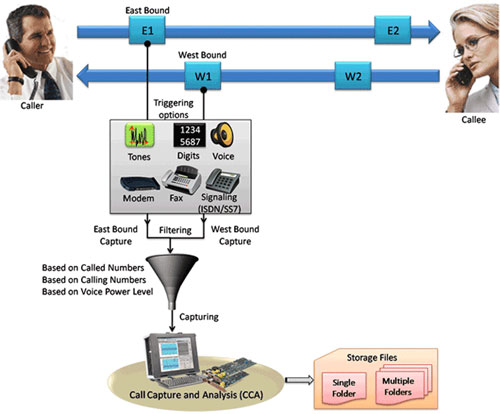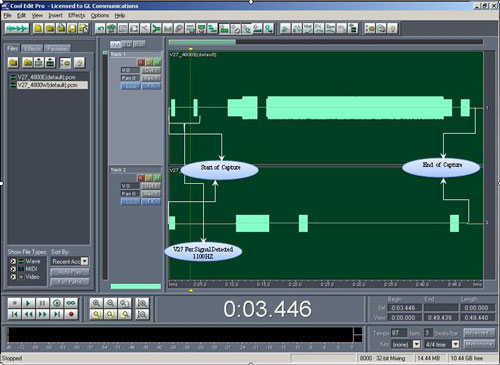Newsletter: GL Announces Enhanced Call Capture and Analysis Software for T1 E1
Welcome to the June 2009 issue of GL's Newsletter providing information and insight into our new product Enhanced Call Capture and Analysis for T1 E1 - software and hardware that allows triggered recording of calls, either automatically or manually directly from T1 or E1 lines.
Overview
The Enhanced Call Capture and Analysis (CCA) application can initiate triggered recording of calls, either automatically or manually directly from T1 E1 lines. The application uses any of three platforms: HD PCI Ultra T1 E1 Cards, or GL's USB Portable T1 E1 Analyzer Units, or Universal T1 E1 Analyzer Cards. Any of these platforms can interface non-intrusively with T1 E1 lines. Automatic call capturing can be triggered from either direction of transmission, east or west.

Auto capturing Support
The call capture application supports following types of triggers for auto capturing of calls
- Signaling based triggers - CAS -R1, wink start, MFC-R2
- ISDN and SS7 message based triggers
- Traffic based triggers
- Voice based on a minimum power level
- Tones of specified frequency - e.g. Ring back tone, Dial tone, Busy tone, and DTMF digits
- Fax traffic - V.32 / V.17, V.27, V.29
- Modem traffic - V.22 forward/reverse channel, V.34 & V.90 uplink, Binary V.90 downlink, FSK
- Any type of signal based on any power level
A typical fax call capture is illustrated below:

After capture, captured calls can be played back and analyzed in time and spectral modes using a commercial sound card, built-in high fidelity speakers, and audio viewing software such as Adobe Audition or Goldwave. CCA software works in conjunction with the CMU (Call Management Utility), to automatically identify captured calls and calls being captured. You can also listen to calls that are in progress. The CMU is especially helpful when a large number of calls are captured such as over a weekend or on many trunks.
Some of the Important features
- Automatic or manual initiation of call recording
- Real-time display of signaling bits for all channels in both directions
- 'Scan' or 'Channel' mode for call initiation detection and capture
- User specified record time
- Automatic termination of recording, or Manual termination
- PCM data captured to two synchronized disk files (east and west directions) for post processing
- All call data are captured including signaling bits, voiceband data, signaling protocol data (e.g. DTMF or MF digits), various types of traffic such as fax, modem, voice, and any type of signal.
- Unlike the other traffic options, triggering on voice traffic can be fine-tuned to the power level of the voice data.
- Voice power level can be set to filter out weak or undesirable voice data
Applications
- Call recording for post analysis
- Analysis of single/dual tones, DTMF and MF digit analysis (frequency, power, duration)
- Analysis of call quality (speech levels, noise levels, echo return loss, speech clipping, impulse noise, and other impairments)
- Call activity, call density, and call volume analysis
- Monitoring and recording ISDN, SS7 and CAS calls
- Filtering of calls by "called" and "calling" number
- Listening to finished calls and active calls as they are occurring
- Remote monitoring of calls including remotely listening to calls
For comprehensive information on the application, please visit T1 E1 Call Capture and Analysis web page.
 Back to Latest News Page
Back to Latest News Page